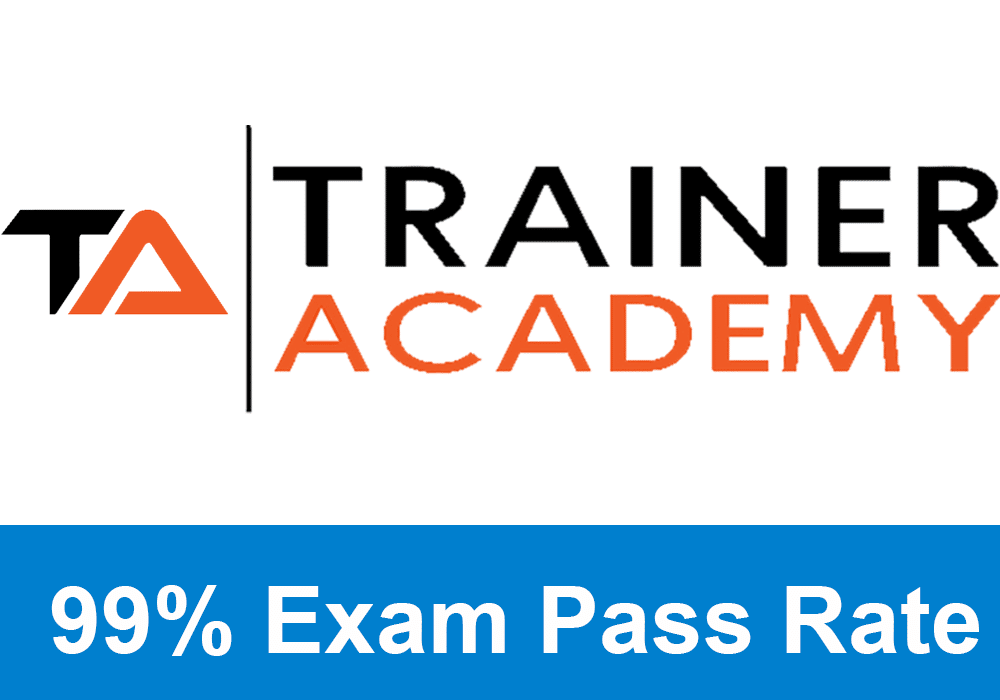![Master Heart Rate Zones: Guide for PT Success in [year] 4 GIF showing Tyler Read open NASM textbook to page on heart zone training](https://www.ptpioneer.com/wp-content/uploads/2024/08/Heart-Rate-Zones-GIF.gif)
Heart rate zones are a vital concept in personal training, offering a structured way to monitor exercise intensity and optimize workouts. Whether you’re preparing for the NASM, ACE, ISSA, or NSCA certification exams, mastering heart rate zones is essential for your success and for helping future clients reach their fitness goals.
For anyone looking to ace your personal training certification, make sure to grab the cheat sheet from Trainer Academy.
In this blog, we’ll cover:
- The definition and importance of heart rate zones
- The five distinct heart rate zones and their training implications
- How NASM, ACE, ISSA, and NSCA incorporate heart rate training into their certifications
- Practical applications of heart rate zone training for client programs
- Study strategies to help you pass your certification exams
By the end of this blog, you’ll have a solid understanding of heart rate zones and how to use them effectively in personal training. If you’re looking for more resources or personalized guidance, contact us at PTPioneer.
Understanding Heart Rate Zones
![Master Heart Rate Zones: Guide for PT Success in [year] 5 Tyler Read holds up NASM textbook to chapter on Heart Rate Zone training cardiovascular chapter](https://www.ptpioneer.com/wp-content/uploads/2024/08/Tyler-Read-with-NASM-Heart-Rate-Training-textbook-1024x682.jpg)
What are Heart Rate Zones?
Heart rate zones are defined ranges of heartbeats per minute (bpm) that correspond to different levels of exercise intensity. These zones help trainers and clients target specific physiological adaptations during workouts, such as improving cardiovascular endurance, burning fat, or increasing anaerobic capacity. Typically, heart rate zones are calculated as percentages of a person’s maximum heart rate (HRmax), which can be estimated using the formula HRmax = 220 – age.
Exclusive PTP CPT Offers |
||
|---|---|---|
Most Popular Cert | Best Online NCCA Cert | Best Study Materials |
Gold Standard Cert | A Good Option | Best CPT for you?  |
The concept of heart rate zones is widely accepted across various fitness and health domains, as it provides a simple yet effective method to quantify exercise intensity and manage training loads. For instance, heart rate zones can guide athletes during endurance training to prevent overtraining, while also helping beginners pace themselves appropriately during exercise.
The Five Heart Rate Zones
- Zone 1 (50-60% of HRmax): This zone represents very light activity, such as a warm-up or cooldown. Training in Zone 1 promotes recovery and improves metabolism with minimal exertion. It’s a good starting point for beginners or for those returning to exercise after a break. Activities in this zone include leisurely walking, light stretching, or yoga, focusing on building a foundation for more intense exercise.
- Zone 2 (61-70% of HRmax): Light intensity exercises like jogging or brisk walking fall into this zone. It helps build aerobic endurance and can be sustained for long periods. Zone 2 is ideal for improving basic cardiovascular fitness and burning fat. This zone is often referred to as the “fat-burning zone” because the body primarily uses fat as fuel at this intensity level. Common activities include steady-state cycling, swimming, or easy running, which help improve overall aerobic capacity without excessive strain.
- Zone 3 (71-80% of HRmax): Moderate intensity, often associated with aerobic conditioning, is found in this zone. Activities like cycling or swimming in Zone 3 improve cardiovascular fitness and increase the body’s ability to transport and utilize oxygen efficiently. This zone is crucial for athletes looking to enhance their endurance and performance in prolonged activities. It’s also effective for individuals aiming to improve their lactate threshold—the point at which lactate begins to accumulate in the blood.
- Zone 4 (81-90% of HRmax): Entering the anaerobic threshold, this zone is reserved for high-intensity efforts like interval training or fast running. It’s effective for improving speed and power but can only be maintained for short durations. Zone 4 training is challenging and pushes the body to improve its lactate threshold, making it easier to sustain higher intensities for longer periods. Exercises in this zone include sprint intervals, high-intensity circuit training, and fast-paced cycling.
- Zone 5 (91-100% of HRmax): This is the maximum effort zone, typically used by athletes during peak performance activities. Training in this zone boosts athletic performance and fast-twitch muscle development. It’s the most intense level of exercise and should be approached with caution, especially for beginners. Workouts in Zone 5 are often short bursts of maximum effort, such as sprints or all-out efforts on a stationary bike, designed to increase VO2 max and overall power output.
How Major Certifications Approach Heart Rate Training
![Master Heart Rate Zones: Guide for PT Success in [year] 6 page from NASM CPT textbook showing the cardio training zones table with a description of each one](https://www.ptpioneer.com/wp-content/uploads/2024/08/NASM-Training-Zones-table-1024x768.jpg)
NASM (National Academy of Sports Medicine)
NASM’s approach to heart rate training is deeply integrated within its Optimum Performance Training (OPT) model, which is a comprehensive framework designed to guide clients through various stages of fitness progression. Heart rate zones in the NASM OPT model are used to ensure clients are training at the right intensity for their goals, whether it’s building endurance, strength, or power.
- Zone 1: This zone is crucial in the Stabilization Endurance Phase of the OPT model, where the primary focus is on building a strong foundation. Clients are encouraged to maintain a heart rate that supports aerobic endurance without overtaxing the body, which helps in the development of aerobic base and overall cardiovascular health.
- Zone 2: As clients progress to the Strength Endurance and Hypertrophy Phases, Zone 2 becomes more relevant. Here, the focus shifts to increasing the intensity to improve the heart’s ability to pump blood more efficiently. Training in this zone enhances the body’s ability to perform at higher intensities while still primarily utilizing fat as a fuel source.
- Zone 3: In the Strength and Power Phases, Zone 3 training is emphasized. This zone is where clients work at a high intensity to push their anaerobic threshold, improving their ability to sustain high-intensity efforts. This phase is particularly important for athletes who need to develop the ability to perform under fatigue.
NASM emphasizes the use of heart rate monitors to track clients’ progress and adjust training intensity based on their current fitness level and goals. The model encourages a progressive approach, where clients gradually move from lower to higher zones as their fitness improves.
ACE (American Council on Exercise)
ACE introduces heart rate zones through its ACE Integrated Fitness Training® (ACE IFT®) Model, which is designed to be adaptable to the individual needs of clients. The ACE IFT® Model focuses on using heart rate zones to guide training intensity, with particular attention to ventilatory thresholds (VT1 and VT2), which are key indicators of a client’s aerobic and anaerobic capacity.
- Zone 1 (Below VT1): This zone is used in the initial phases of the ACE IFT® Model to build a strong aerobic base. The focus is on enhancing the body’s ability to use oxygen efficiently during prolonged exercise. Activities in this zone are generally low to moderate in intensity, helping clients develop the endurance necessary for more intense training.
- Zone 2 (Between VT1 and VT2): As clients progress, training intensity is increased to fall within Zone 2. This zone helps improve aerobic efficiency and is crucial for clients looking to increase their endurance and stamina. Training in this zone is often characterized by a balance of fat and carbohydrate utilization for energy.
- Zone 3 (Above VT2): This high-intensity zone is used in the later phases of the ACE IFT® Model, focusing on anaerobic power and endurance. It is designed to improve clients’ ability to perform short bursts of high-intensity activity followed by periods of recovery. This zone is critical for athletes and clients who need to perform at peak levels.
The ACE IFT® Model uses heart rate monitors and the talk test to assess a client’s ventilatory thresholds, ensuring that the intensity is appropriate for their fitness level. This approach allows for a more personalized training experience, with adjustments made based on real-time feedback from the client’s body.
Exclusive PTP CPT Offers |
||
|---|---|---|
Most Popular Cert | Best Online NCCA Cert | Best Study Materials |
Gold Standard Cert | A Good Option | Best CPT for you?  |
ISSA (International Sports Sciences Association)
ISSA takes a practical approach to heart rate training, emphasizing the application of heart rate zones in various fitness programs. The ISSA certification program categorizes exercises into five zones, each linked to specific training goals.
- Zone 1: This zone is recommended for active recovery and for clients who are new to exercise. Training at this intensity helps to promote recovery by increasing blood flow and oxygen delivery to muscles without placing undue stress on the cardiovascular system.
- Zone 2: ISSA highlights this zone for its fat-burning potential. It’s often used in steady-state cardio sessions where the goal is to maximize fat oxidation while maintaining a manageable exercise intensity. This zone is particularly beneficial for clients aiming for weight loss or those looking to build a strong cardiovascular foundation.
- Zone 3: In this zone, the focus is on improving aerobic capacity and endurance. ISSA trainers use this zone to prepare clients for more intense training sessions by gradually increasing the intensity and duration of workouts. It is also used to enhance the body’s ability to utilize oxygen during prolonged physical activity.
- Zone 4: This high-intensity zone is used for interval training and to push clients to their anaerobic threshold. ISSA recommends incorporating Zone 4 training for clients who are preparing for competitive events or who want to increase their speed and power. The training in this zone is intense and is usually followed by periods of rest or lower-intensity exercise.
- Zone 5: This zone is reserved for maximum effort and is used sparingly in most ISSA programs. It’s typically included in high-intensity interval training (HIIT) sessions where the goal is to maximize cardiovascular performance and increase VO2 max. Training in Zone 5 requires careful monitoring to avoid overtraining and ensure that clients are adequately recovered before the next session.
ISSA trainers are encouraged to use heart rate monitors and other fitness trackers to gather data on clients’ performance, which can then be used to adjust training programs and ensure that clients are working within their optimal heart rate zones.
NSCA (National Strength and Conditioning Association)
NSCA’s approach to heart rate training is scientific and data-driven, with a strong emphasis on the use of heart rate reserve (HRR) to determine exercise intensity. The Karvonen method, which is widely used in NSCA training programs, takes into account both resting and maximum heart rates to calculate the appropriate training intensity for each client.
- Heart Rate Reserve (HRR): NSCA uses the Karvonen method to calculate heart rate zones, which provides a more personalized measure of exercise intensity. HRR is calculated by subtracting the resting heart rate (RHR) from the maximum heart rate (MHR) and then multiplying this value by the desired intensity percentage before adding back the RHR. This method allows for a more accurate reflection of an individual’s fitness level and helps to ensure that clients are training at the correct intensity.
- Zone 1: This zone is used for low-intensity training and active recovery. NSCA emphasizes the importance of this zone for recovery sessions, where the goal is to promote muscle repair and reduce the risk of overtraining.
- Zone 2: In this zone, the focus is on aerobic endurance training. NSCA trainers use this zone to build a client’s cardiovascular base, which is essential for sustained performance in endurance sports. Training in Zone 2 helps to improve the efficiency of the cardiovascular system and increases the body’s ability to use fat as a fuel source.
- Zone 3: This moderate to high-intensity zone is used to improve lactate threshold and aerobic capacity. NSCA trainers use Zone 3 training to help clients improve their ability to perform at higher intensities for longer periods. This zone is crucial for athletes who need to maintain a high level of performance over extended periods.
- Zone 4: NSCA emphasizes Zone 4 for its role in enhancing anaerobic capacity and peak power output. Training in this zone is used to prepare athletes for competition by pushing them to their limits in controlled settings. This zone is also used for high-intensity interval training (HIIT), which is effective for improving both aerobic and anaerobic systems.
- Zone 5: Reserved for maximum effort, this zone is used sparingly in NSCA programs. Training in Zone 5 is designed to increase VO2 max and enhance the body’s ability to perform at peak levels. This zone is typically used for advanced athletes who are preparing for high-intensity competitions.
NSCA trainers are taught to use heart rate monitors and data analysis to track client progress and make informed decisions about training intensity. This data-driven approach ensures that clients are training at the appropriate intensity levels for their specific goals.
Heart Rate Zones Practical Applications and Tips
Implementing Heart Rate Zones in Training Programs
Heart rate zones are a valuable tool for personal trainers, offering a method to customize workouts to client needs. Here’s how to implement them effectively:
- Assessment: Start by assessing the client’s current fitness level to determine the appropriate starting zone. Use methods like the 3-minute step test or Rockport Walk Test to gauge cardiovascular fitness. The results of these assessments can help you identify the client’s aerobic capacity and determine the most suitable heart rate zones for their training.
- Customization: Tailor workouts to target specific heart rate zones based on client goals. For example, a client looking to improve endurance might focus on Zone 2, while a client aiming to increase anaerobic capacity might train more in Zone 4. Customizing workouts to fit individual goals ensures that clients are working at the correct intensity to achieve their desired outcomes.
- Monitoring: Utilize heart rate monitors or fitness trackers to ensure clients stay within their target zones during exercise. This real-time feedback helps adjust intensity on the fly, ensuring clients are getting the most out of their workouts. Monitoring heart rate also allows trainers to track progress over time and make necessary adjustments to the training program.
- Progression: As the client’s fitness improves, gradually increase training intensity by moving them from lower to higher zones. This progression helps avoid plateaus and keeps clients challenged. Progressive training ensures continuous improvement and helps clients build on their successes.
- Safety Considerations: It’s important to monitor client responses to exercise, especially in higher heart rate zones. Watch for signs of overexertion, such as dizziness, shortness of breath, or irregular heartbeats, and adjust the workout intensity accordingly. Ensuring client safety is paramount, and trainers should be prepared to make modifications as needed to protect the client’s well-being.
Study Tips for Certification Success
To excel in your certification exam, understanding heart rate zones is crucial. Here are some tips to help you prepare:
- Understand the Models: Familiarize yourself with the specific heart rate zone models used by each certification body. Knowing how each organization defines and applies these zones will be key to answering exam questions accurately. Reviewing the study materials provided by NASM, ACE, ISSA, and NSCA will give you a comprehensive understanding of how heart rate zones are integrated into their training philosophies.
- Apply Knowledge Practically: Practice calculating target heart rates and creating training plans based on different heart rate zones. This practical application not only helps reinforce the concepts but also prepares you for real-world scenarios you’ll face as a trainer. Working through case studies or practical examples can help solidify your understanding of heart rate zones.
- Use Practice Exams: Test your knowledge with practice exams that focus on heart rate training concepts. These exams will help you identify areas where you need further study and give you a feel for the types of questions you might encounter. Practice exams are a valuable tool for gauging your readiness and pinpointing areas for improvement.
- Focus on Client Scenarios: Many certification exams include questions about how to apply heart rate zones in various client scenarios. Practice writing out how you would approach different client cases, incorporating heart rate zone training to achieve specific goals. Understanding how to apply theoretical knowledge in practical settings is essential for success on the exam and in your future career as a trainer.
Conclusion
Heart rate zones are a fundamental tool in personal training, offering a way to measure and guide exercise intensity effectively. By mastering this concept, you can enhance your training techniques and significantly increase your chances of passing your certification exams.
For more resources and personalized training tips, visit PTPioneer or contact us today.
Heart Rate Zones FAQs (Frequently Asked Questions)
What are heart rate zones?
How can I calculate my target heart rate?
Why are heart rate zones important for training?
How do NASM, ACE, ISSA, and NSCA differ in their approach to heart rate training?
What information is needed in order to calculate a training heart rate zone?
It’s best to work within what zone to achieve better fitness and more health benefits?
What is the zone in which your heart rate should stay for a healthy and safe workout?
What is the upper limit of the target heart rate zone called?
What is a good “warm-up” heart rate (bpm)?
What two zones make up our target heart rate zone?
Why is it important to reach your target heart rate zone when exercising?
What is the target heart rate zone?
What is the range of heart rates that create the best training for aerobic fitness?
Which heart rate zone is typically considered to be the anaerobic training zone?
When is the best time to measure your target heart rate zone?
To achieve a good fitness level your resting heart rate should be below how many beats per minute?
References
- Clark, M. A., Lucett, S. C., Mcgill, E., Montel, I., & Sutton, B. (2018). NASM essentials of personal fitness training. Burlington Jones & Bartlett Learning.
- Coburn, Jared W, and Moh H Malek. NSCA’s Essentials of Personal Training, 2nd ed., Human Kinetics.
- Scott, Vanessa, et al. Foundations and Applications for a Certified Personal Trainer. 10th ed., ISSA, LLC, 2021.
- Bryant, Cedric X., et al. ACE Personal Trainer Manual. 5th ed., American Council on Exercise, 2014.

 Have a question?
Have a question? 
Tyler Read
PTPioneer Editorial Integrity
All content published on PTPioneer is checked and reviewed extensively by our staff of experienced personal trainers, nutrition coaches, and other Fitness Experts. This is to make sure that the content you are reading is fact-checked for accuracy, contains up-to-date information, and is relevant. We only add trustworthy citations that you can find at the bottom of each article. You can read more about our editorial integrity here.